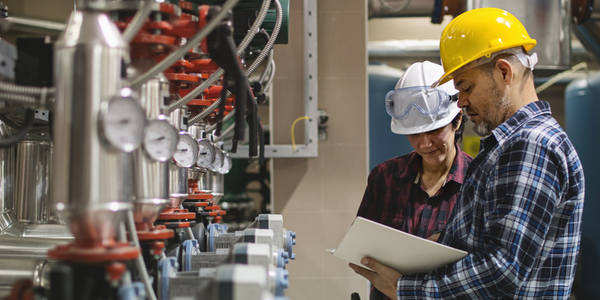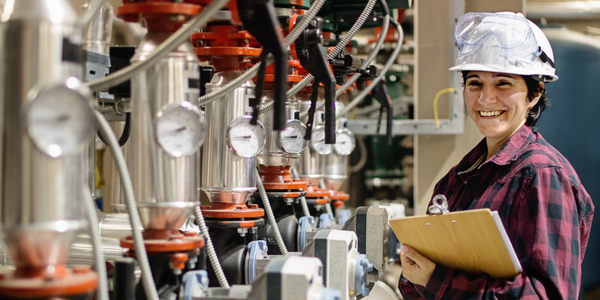What is the difference between a maintenance worker, a maintenance technician, and a maintenance engineer?
The main differences between a maintenance worker, a maintenance technician, and a maintenance engineer are their titles and their day-to-day tasks. You'll see people with all three job titles across industries - from hotels and hospitality, to manufacturing. The three roles have overlapping skillsets and responsibilities, but they may specialize in different areas or the types of tasks they are most often performing.
What is the difference?
A maintenance worker's duties may be less technical than, say, a maintenance technician. Maintenance workers often take on more of a handyman role, performing routine maintenance on common breakdowns.
A maintenance technician, on the other hand, tends to perform maintenance procedures in "hard hat" settings. These procedures are often more technical and specific than some of the general maintenance tasks, often requiring additional experience and industry knowledge.
Finally, a maintenance engineer is involved with the planning and design processes of equipment and maintenance programs. Engineers may perform technical tasks as well, but it is their responsibility to apply concepts to a facility's maintenance plan and procedures in a way that optimizes equipment efficiency.
Let's take a deeper look into each role.
Maintenance workers

Looking at each individually, let’s see what the Bureau of Labor Statistics has to say about maintenance workers. Some of the general stats include:
- High school diploma or equivalent required
- 1.4 million jobs as of 2016
The job description boils down to working on machines, equipment, and buildings in a variety of settings, such as hotels, hospitals, apartments, universities, and so on. Their typical tasks may include machine repair work, flooring, painting, plumbing, electrical work, HVAC repairs, and so on.
Maintenance technicians

A maintenance technician, on the other hand, tends to be more specialized. Again looking at BLS statistics, we see the following:
- High school diploma or equivalent
- 476,100 jobs in 2016
The job market for maintenance is technicians less widespread. That said, maintenance workers and maintenance technicians job markets do have similar rates of growth: 8% for general maintenance, and 7% for maintenance mechanics.
As for the job description, most maintenance technicians work in manufacturing facilities and are highly-skilled individuals. The scope of work and degree of specialization of a technician may depend on the size of operations of the facility and the number of assets that need to be maintained. They are responsible for the upkeep of a facility, and their tasks include the maintenance and repair of industrial machinery, such as factory equipment, conveyor systems, packaging machines, and so on.
A bigger facility with several types of equipment may need a team of technicians, each with a specialized set of skills. Additionally, safety is a much greater concern here, and multiple precautions must be taken to prevent accidents. Technicians typically follow procedures that need to be precisely carried out when servicing assets or when performing tests to gauge the health of equipment. These procedures are essentially guides that were developed by engineers and scientists to ensure that crucial components are checked. By working according to a consistent procedure document, potential causes of incidents can be more consistently addressed.
Maintenance engineers

Maintenance engineers are the highest level of specialization among the three roles discussed in this article. The BLS statistics for maintenance, or industrial, engineers tell us:
- Bachelor's degree or higher
- 257,900 jobs in 2016
While maintenance technicians cover the “hands-on” aspects of plant activities, the maintenance engineers handle the planning and analysis components of the job. The background of engineers in science and math allow them to systematically identify problems and prepare for potential incidents.
Engineers are expected to design the tests and procedures required to collect and analyze data that provide insights on equipment and assets. From the given data, engineers can develop strategies to effectively carry out maintenance tasks and address issues that affect the overall performance of the plant.
Similar but distinct roles
It is important to note that while the roles of workers, technicians, and engineers are similar, they are not the exact same. There are specific nuances and tasks associated with each title, though sometimes they're used interchangeably. Clearly defining the roles and expectations from workers, technicians, and engineers within a team or facility enables efficiency and effectiveness. You can count on your workers and technicians to keep the plant running and operating on a daily basis, while the engineers take a broader look and plan ahead to keep the pace running consistently and improving continuously.
How do I choose the right profession for me?
When looking at these three professions, the one you ultimately choose depends on your own preferences. Industrial maintenance positions are more specialized, but a bit more perilous than general maintenance work. Maintenance engineering often requires the highest amount of education and the ability to evaluate processes.
In general, if you’re a jack of all trades and want to perform a variety of tasks, general maintenance work could make for a satisfying profession.
On the other hand, if you want to work in a more specialized field involving heavy machinery, then working as a maintenance technician may be more to your liking.
Or, last but not least, if you love process planning and procedure engineering, maintenance engineering is the right path for you.
Want to keep reading?
Types of Maintenance Workers
How do I progress in my career as a maintenance engineer?
Maintenance Technician
4,000+ COMPANIES RELY ON ASSET OPERATIONS MANAGEMENT
Leading the Way to a Better Future for Maintenance and Reliability
Your asset and equipment data doesn't belong in a silo. UpKeep makes it simple to see where everything stands, all in one place. That means less guesswork and more time to focus on what matters.

![[Review Badge] Gartner Peer Insights (Dark)](https://www.datocms-assets.com/38028/1673900494-gartner-logo-dark.png?auto=compress&fm=webp&w=336)
